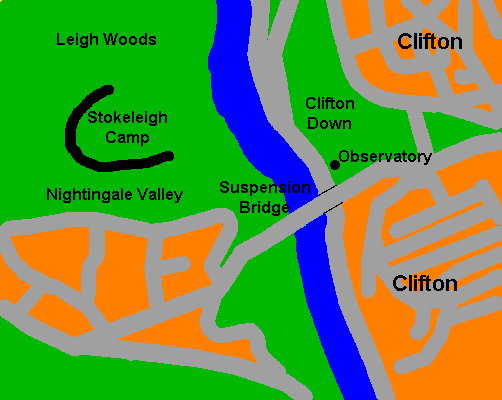
The Avon Gorge area around the Suspension Bridge
The little area shown in the map above is well worth a couple of hours visit. The area is dominated by the Clifton Suspension Bridge which is easily Bristol's most distinguishable feature.
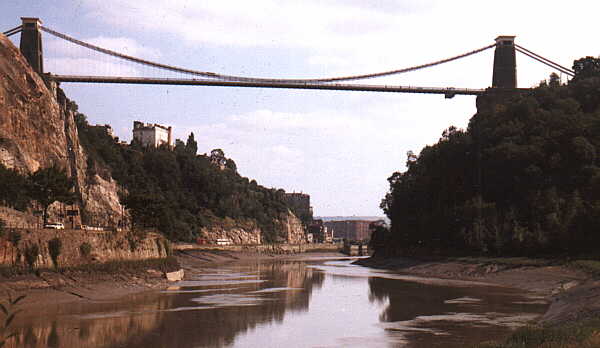
Clifton Suspension Bridge from Nightingale Valley
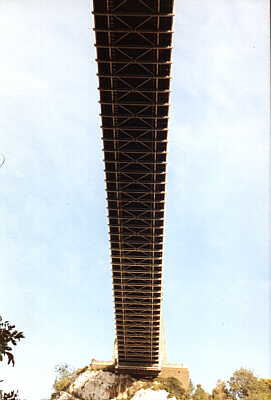
An unusual view of the Suspension Bridge from Nightingale Valley
This magnificent piece of engineering was planned by Isambard Kingdom Brunel in 1829, but the building of it was plagued by financial difficulties. Work started on it in 1831 but the money soon ran out and work stopped for five years. It was finally opned on 8th December 1864, but Brunel didn't see it as he died in 1859. It has a span of 702 feet and is 245 feet above the river.
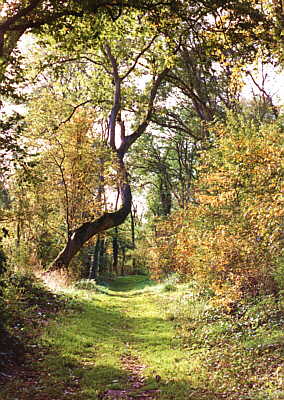
Nightingale Valley
The walk along Nightingale Valley will lead to Leigh Woods and the Iron Age Stokeleigh Camp. The earthworks are now partially wooded but the massive defensive ditches can still be seen. Leigh Woods covers about 190 hectares (430 acres). Originally owned by St. Augustine's Abbey, at the dissolution it passed to Sir George Newton and later to the Smyth family of Ashton Court. The woods now bear little evidence of the extensive seventeenth century quarrying. Lime was quarried here and there were several lead and iron smelters that used locally produced charcoal.The track has been in existence for over 2,000 years and ran from the forts in Leigh Woods to a low-tide ford across the Avon.
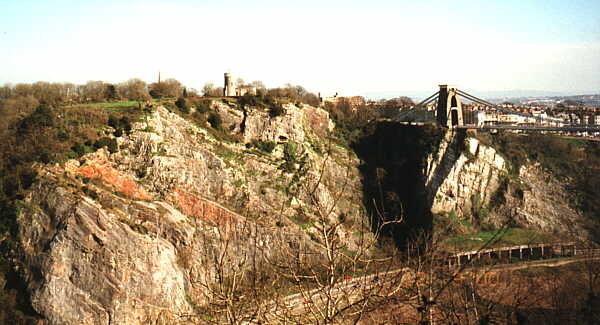
A view of Clifton from Leigh Woods
The photograph above shows several interesting features. From the left there is the massive bulk of Vincent's Rock, on top of which is the Observatory and Camera Obscura. To the right and below the Observatory is the Giant's Cave, the entrance to which is inside the Observatory. To the right of this is the Suspension Bridge. This Bridge sees to have a fascination for some people, pilots have flown aircraft under it, people have bungy jumped off it, been thrown from it or decided to end it all by from jumping from it. Perhaps the most interesting thing about these falls is that some of them actually survive it, not bad going considering it's a drop of 245 feet. Parts of the gorge have to be inspected and loose rock dislodged before it falls into the roadway and there is now an extensive network of netting to prevent such falls. The alpine style canopy was built to protect the Portway and its users from further rock falls but the position of it still leads many of us to believe it's there to stop suicides from crashing into the roadway.
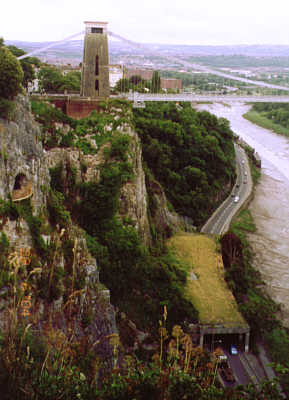
Another view of the alpine canopy
In the left middle of this image can be seen tunnel outlook from the Observatory
There have been quite a number people jumping off of the bridge. Over a thousand people have so far committed suicide by doing this. Bristol and the surrounding area has a suicide rate by jumping of 9.3% compared with 4.9% of all suicides in the rest of England and Wales. Among those who have fallen (or jumped) from the bridge was Samantha, the daughter of the famous Welsh singer Shirley Bassey. She'd been drinking in the Hotwells area and was found under the bridge in 1985.
Here's a story from the "Illustrated Police News" issue 444, dated Saturday, August 17th, 1872...
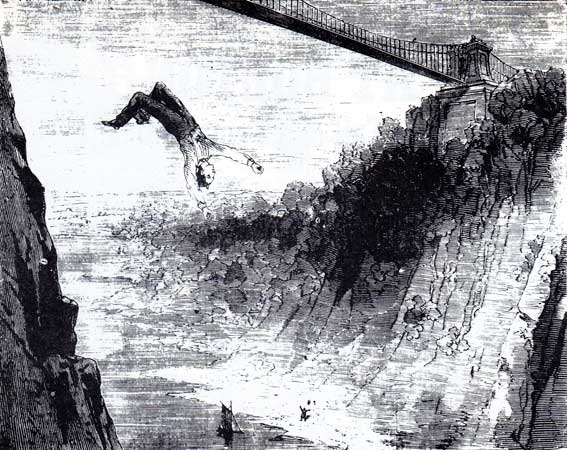
Suicide from the Bridge at Clifton, Bristol
A report of this meloncholy affair appeared in our edition last week, which doubtless will be fresh in the memory of most of our readers. We subjoin, however, a resume of the facts:- A man was seen to get over the suspension bridge. The height of the structure is 245 feet above high water mark, and the low water point upon which the unhappy young man fell was some twenty feet below that. It would seem that the poor fellow paid his toll at the gate for crossing the bridge, and proceeded as far as the centre of the bridge on the upper or Bristol side, and that then, having denuded himself of his hat, coat and waistcoat, he clamberd over the parapet and rushed to his death.
He was seen by persons at the Hotwells to get over the rail of the bridge and hang on by both hands. In a few moments he released one of them and almost insantly was seen tumbling over and over through the air into the abyss below. Owing to some barricades which have been raised along the banks of the Avon to cover some extensive works going on in connection with the improvement and extension of the harbour, the persons on the Gloucestershire banks of the river did not see him actually strike the mud, but Mr. Wilkinson the resident engineer of the port and pier railway, who happened to be passing, heard a loud "thud" or sound, which he at first supposed might have been caused by blasting the cliffs, and on running to an opening in the planks of the balustrade, he saw the poor fellow's body on the mud lying on his back. Mr. Wilkinson at once obtained the assistance of some of his men, and the body was got up and removed to "The General Draper Tavern" where it was handed in charge of the police.
Some very, very lucky people have survived the fall. Here's some of their stories.
On Friday 8th May 1885, 22 year old Sarah Anne Henley, after a lover's quarrel, tried to commit suicide by jumping off of it. Sarah was from the St. Philip's area and was a factory worker. The large Victorian dress she was wearing acted as a parachute and she survived the fall. She escaped with light bruising but very deep shock. One account I heard of this is that a carriage driver refused to take her to hospital, she had landed on the riverbank and was covered in mud and he didn't want to get his carriage messed up. Incidentally, she went on to see her 85th birthday and died in 1948.
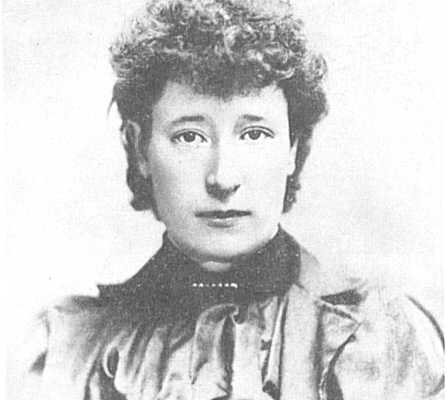
Sarah Anne Henley
One of the most horrific stories is that of Ruby and Elsie Brown. Their father, Charlie, a grocer from Birmingham was close to bankruptcy and very despondent. On 18th September 1896, he took his young daughters, Ruby and Elsie, onto the bridge and threw them over the parapet. Luckily, on a boat underneath the bridge was Pill pilot James Hazell and his crew who picked the girls up and took them to the shore. Two policemen P.C. Wise and Sgt. Willie picked up the unconscious girls and ran all the way to the Bristol Royal Infirmary with them. Elsie had slight leg injuries but Ruby had spinal injuries but after a couple of weeks made a good recovery. At their father's trial Ruby said that "We stayed on the bridge about an hour. I was soaking wet and so was Elsie. Father caught hold of me and I began to scream. He lifted me up on the side of the bridge and put me over." Charles Brown was found to be insane and placed in an asylum.
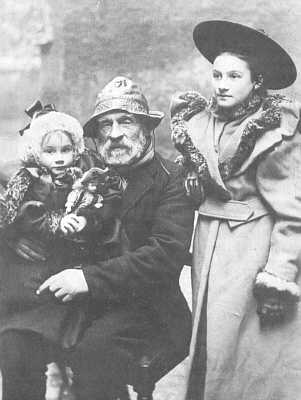
Ruby and Elsie Brown
The above stories were taken from "Offbeat Bristol" by James Belsey and "Bristol Panorama" by Doreen Street
One of the luckiest people alive must have been a bridge worker, Gilbert Taylor or maybe Tailor, who was a painter on the bridge in 1956. Someone had taken their coat off and left it on the parapet. A gust of wind took the coat and it hung on a ledge just out of reach. George leant over to get it and fell 80 feet into the trees below the bridge and broke two ribs and suffered severe bruising. NOW that's a story to tell your grand-children. I can remember seeing a collection of old newsreels when a local news crew interviewed him just a couple of days after his fall on the television in the 1970's. In September 2011, I was poking around on the Bristol Film and Video Society website and was looking at a Clifton Suspension Bridge film clip on their site which contained a short piece about George and his fall. Of course, I cannot find he clip now, but here's some still from it...
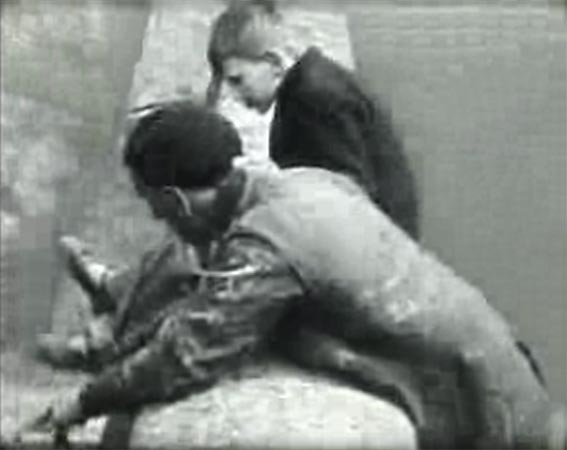
Gilbert pointing out where he landed
Notice the young boy sat on the parapet of the bridge
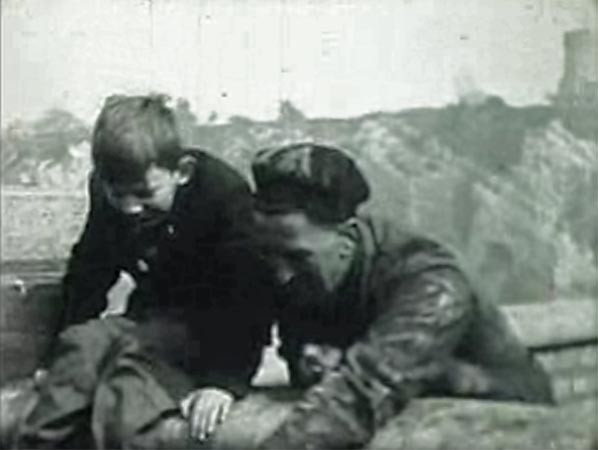
In January 2005, Dave Roach emailed me about his grandfather who was often called upon to retrieve the bodies from the river Avon (often the suicides from the Clfton suspension bridge) as he knew the currents and where to look, he was once called upon to retrieve a very noble woman believed to be from one of the aristocracy families or even royalty living in the Bristol area that committed suicide from the bridge. It was believed that the search had taken place for around a week before they asked his advice, then they were able to recover the body in a few hours of searching. Being the type of man he was that in most cases the bodies were discovered on the Avon side of the river as they paid him 2 crowns instead of the Somerset side that only paid 1 crown per body.
This page created March 18, 2000; last modified October 29, 2022










